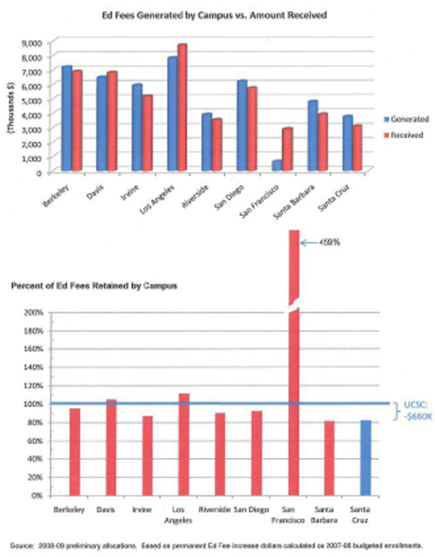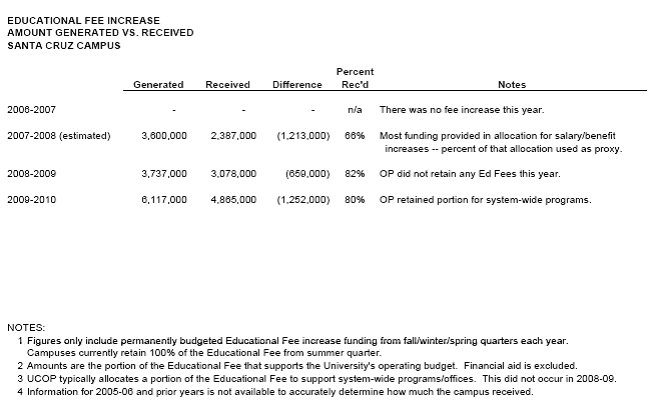by Bob Meister,
President, Council of UC Faculty Associations
Professor of Political and Social Thought, UC Santa Cruz
(A PDF version of this article is available.)
UC feels free to use Educational Fees however it pleases without accountability. That’s why it can pledge “ed fees” as collateral for construction bonds and use them to pay debt service.[1] In the past week, I have discovered another, equally disturbing, consequence of UC’s refusal to be accountable for its use of “ed fees:” It has allowed (or perhaps more accurately used) the rapid growth in “ed fees” to dramatically increase the disparities in the per student funds it provides to each campus. As tuition rises, students are not getting what they think they are paying for on their own campuses, and the entity they are paying has not been transparent about where the money goes.
Why was this discovery so shocking? I knew that UC distributes enrollment-generated revenue unequally among the campuses. But this was so, I believed, for purely historical reasons. Over twenty years ago, when state funds far exceeded “ed fees,” UC let the more established campuses lock in a higher base budget (justified by a higher proportion of grad students) while requiring that all future budget increases be funded across the system on an equal per student basis. Although state funds are still distributed unequally under this formula, it was natural to assume that the principle of funding all UC students equally across the system would apply not only to new state funds, but also to any increase in tuition that was charged uniformly across the system. But UC has not held itself to any principle governing its use of tuition. As “ed fee” revenue tripled over the past twenty years—it now exceeds UC’s total state funding—UC reintroduced differential rates of per student funding on the tuition side, which meant that the campus funding differentials increased as system-wide tuition went higher. By funding campuses unequally out of tuition, UC implicitly reneged on the principle of equal distribution that it would have applied if UC revenue growth had occurred primarily through state funding, rather than through “ed fee” increases. Someone in UC’s Office of the President made this decision in secret. Until this year there was no consultation with the Academic Senate (even some Chancellors were kept in the dark) about the formula for returning “ed fees” to the campuses.[2]
The bar graphs below (made public by UCSC Chancellor Blumenthal) show that UC’s present policy is to return to seven campuses as little 80% of the annual “ed fees” generated by them so that it can return considerably more to three campuses. UC provides no explanation for this disparity—“ed fees” are distributed at its discretion. It should be noted, moreover, that the dollar-effect of the “ed fee” return gap becomes greater as tuition grows, and that undergraduate tuition will have risen by 76% from 2007-2008 (the basis for the graph) if the proposed November fee increases take full effect in 2010-2011.[3] UC’s intended distribution of “ed fee” increases will make campus funding even more unequal without apparent justification. This is another example of UC’s ability to do whatever it wants with “ed fees,” and provides yet another reason to oppose further “ed fee” increases until UC makes itself accountable for how these funds are actually used.

UC typically deflects demands for actual accountability by telling stories about why it needs to do the things being questioned. It might, for example, say that it needs flexibility to help research-heavy campuses with lots of grad students. But it rarely provides an evidence supported, principled justification for engaging in practices that appear inequitable on their face. This leaves its critics wondering whether to simply take its reasons on faith or to look for other explanations. It’s possible, for example, that UC jiggers the return of “ed fees” to campuses in response to pressure from administrators with the strongest personal UCOP connections, or in response to political pressure from external constituencies who favor a particular campus or discipline or professional school field. Or perhaps UC is diverting “ed fees” to more favored campuses to help them finance construction. Or maybe it is using “ed fees” to invest in medical centers that make money, or to subsidize medical centers that lose money. Or it might simply be following old formulas for distributing “ed fees” that are so out of alignment with current conditions that they are unintentionally depriving some campuses of desperately needed funding that is unfairly going to others. UC may be making ad hoc or poorly considered changes in the allocation of the flows precisely because this is unrestricted money for which it is not held accountable.
President Yudof, who is new to the UC system, has not tried to rationalize the graphs that appear above. Here’s what he told the Daily Cal:
I think [UCSC Chancellor] George [Blumenthal] is on to something here. What happens is the state money for grad students comes in as a block to the system and then we distribute it out to the campuses. We have some formulas for doing that that have been there for a very long time. ….It’s broken. I promised George, and you have my word and faith of honor, and this predates me, that we’re gonna try to fix it and make the formulas more transparent and fairer. …I think those are valid points–the formula is old and it’s not transparent. …We actually have teams of people looking at that, I suspect we’re gonna be changing those formulas.[4]
President Yudof ‘s response runs together the still-unequal distribution of UC’s shrinking state funds and the increasingly unequal distribution of UC’s growing tuition funds, but he clearly recognizes that both formulae are unfair. Yet he still wants a 32% tuition increase that will make the distribution even more unfair. Why? All UC’s leaders insist that “[e]very fee increase since 1990-91, with one exception (in 2007-08), has been levied to make up for inadequate state funding.”[5] There are also, however, many UC tuition comparison studies demonstrating that ours is too low on the assumption that the price that students will pay for higher education is independent of the subsidy their university happens to receive from the state or an endowment. It seems that UC planned to raise tuition regardless of the level of state funding, and timed the largest increases to coincide with large state budget cuts.
Based on publicly available data we can say only a limited amount more about the link between the most recent tuition increases and state budget cuts. It’s clear that the enrollment funding UC receives from the state is now $5K per student less than in 2006-2007; but, even in that year, the most advantaged campuses received twice what the least advantaged campuses received from the growing pot of student fee funds that UC gets from both tuition and the state.[6]
We do know that tuition increases exacerbate the disparities in inter-campus funding. As the disparities increase, the painful cry that students are paying more for less becomes louder on the disadvantaged campuses. Can the inter-campus differentials be justified? Should students be asked to pay tuition increases that will go disproportionately to other campuses? The answer depends partly on whether UC’s internal funding policies can be justified, and whether it holds itself accountable for following its own policies. Thus far it has provided neither justifications nor accountability.
Further tuition increases should be stopped until UC accounts for where this money has gone and will go. It must produce a principle based, evidence supported explanation for how it is distributing ed fees. The money involved is not an abstract flow of dollars moving from students to UC’s bank accounts and back to the campuses. Some of this money has been scraped together by low and middle income families who must take out second and third mortgages to send their children to UC. Does it make sense, from the perspective of the UC system as a whole, to ask the parents of children attending UC Merced, Irvine, Riverside, Santa Cruz, and Santa Barbara (and even Berkeley) to subsidize the favored campuses without disclosing that subsidy, or how it is actually used by the campus receiving it? Such subsidies might have been tolerable in an earlier time, when tuition was lower. But at this point, they appear as an increasingly unfair shift of the financial burden to students who may not benefit from the tuition dollars they believe they are putting toward their educations.
November 10, 2009

[1] Meister, “They Pledged Your Tuition” I-III, http://www.cucfa.org/news/tuition_bonds.php
[2] The most recent “ed fee” return figures for UCSC are attached to illustrate the systemwide problem.
[3] Source: http://budget.ucsf.edu/downloads/student-fees-1960-present.xls
[4] http://www.dailycal.org/article/107121/uc_president_discusses_systemwide_financial_crisis
[5] http://www.universityofcalifornia.edu/news/article/22164
[6] http://www.universityofcalifornia.edu/finreports/index.php?file=/07-08/finschd.html; http://www.ucop.edu/budget/enroll/2007-08.pdf